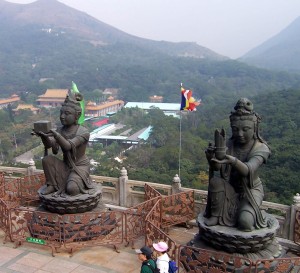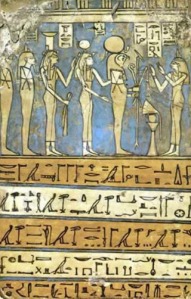It seems we have always made offering to our Deities. Many have also honored their dead with offerings, as the ancient Egyptians did. Our ancestors offered the choicest cut of meat to the Great Hunter Who had helped them in their hunt. They gave the first handful of ripe berries to the Wild Mother Who had guided them to the mouth-watering cache. They shared their holy days and good fortune by offering feasts to their dead. They filled temples with sumptuous meals and beautiful scents for the Goddesses and Gods. They created art in enduring stone and precious metals and offered it to the Divine Houses.
From Christian tithing to Hindu puja to the stargazer lilies I grow and place upon Isis’ altar, we humans continue to make offering. Perhaps there is something of an inborn impulse to do so.
I came across what I take as an example of that innate impulse one day when visiting the Seattle Troll. Large enough to hold a VW Beetle in one hand and staring out of a single, glassy eye, the Seattle Troll lives beneath the Aurora Bridge in Seattle’s Fremont neighborhood. He was originally a work of art funded by the city, but he has become something more. He has become a Work of Art and now receives offerings from passersby and neighborhood residents.
The day I visited—not a special day, just a weekday like any other—the Troll was supplied with an amazing array of offerings. There were fresh flowers, smoked almonds, jewelry, coins, jams, a bag of fresh cherries, a whole watermelon, a bright pink-orange slab of raw salmon, a whole Dungeness crab, a bar of soap, a pack of cigarettes, two coffee mugs, and two t-shirts. These offerings were fresh, too, the flowers and food as yet unwilted. At first, it looked like someone had temporarily left their picnic. But no. The votives were carefully arranged upon the enormous hands of the Troll. They were clearly presented, and no picnickers were to be found. The items were offerings and nothing less.
I doubt that any of those who offer to the Troll see him as a Deity—at most, he’s a quirky neighborhood spirit. Yet people leave offerings just the same.
Perhaps it’s because when we make offering we are seeking relationship. In the case of the Troll, perhaps we seek connection with the progressive spirit of the neighborhood. Maybe the Troll’s mere existence gave us a chuckle and we offer a gift of thanks, connecting with those who share our amusement or with the Troll’s artist-creators. Perhaps the offerings were intended to be discovered by someone in need, as Hekate’s Supper offerings were meant.
In a divine context, making offering can be a joyful sharing of blessings with the Deity or spirits with whom we have or seek a relationship. As an act of gift giving, offering is a universal way to create the sweet bonds of interconnection and ongoing reciprocity between giver and receiver. Offering encourages generosity in the giver. Some Tibetan Buddhists say that it is this growing generosity in ourselves that pleases the Deities, rather than the actual offerings. Offering can be a meditation, a prayer, a way to honor tradition, an act of devotion, a method of giving thanks, a path to greater openness of spirit.
Making offering was essential to the Egyptian relationship with the Divine while the relationship itself was essential to the proper functioning of the universe. The Egyptians knew that the universal order hinged upon the ongoing, interwoven relationship between Divine and human, natural and supernatural. If human beings failed to provide right worship to the Deities—a significant part of which was the act of making offering—the world would dissolve into chaos and the Goddesses and Gods would not have the energy required to maintain and renew the physical universe. The exchange of energy, the building of relationship made the act of offering an ongoing renewal of the world in partnership with the Deities.
In fact, offering was considered such a key part of the functioning of the universe that there are numerous representations of Deities making offering to each other. From Isis’ temple at Philae, we learn that the Goddess made libation offerings to Her beloved Osiris every 10 days. The temple calendar from Esna notes that She also made offering to Osiris (and to another Deity Whose name is lost) on the 10th day of the first month of the season of Inundation.
In ancient Egyptian temples, the offerings were often food and drink, flowers, incense, perfume, and even special items associated with the particular Deity: jewelry for Hathor, hawk feathers for Horus. Symbolic offerings were given too. The Eye of Horus, for example, could represent many different types of offerings and statuettes of Ma’at were given to represent the offerant’s dedication to upholding the Right and the Just and the True, which is the Being and Nature of the Goddess Ma’at.
But today, I’d like to talk about a particular type of offering, one that may be especially appropriate to Isis as Lady of Words of Power and, as She was called in Busiris, Djedet Weret, the Great Word. Egyptologists today call it an “invocation offering.” Egyptians called it peret kheru, the “going forth of the voice.”
We’ve talked many times about the power of the word in Egyptian practice. Isis conceives something in Her heart, then speaks it into existence. Words can establish, they can move magic, they can nourish and renew the spirit. A Hermetic text from the early centuries of the Common Era expressed the genuinely ancient Egyptian tradition that the quality of the speech and the very sound of the Egyptian words contain the energy of the objects of which they speak and are “sounds full of action.” This is precisely why words are powerful: they contain the energy of the objects they name, which is the energy of original Creation.
Because of their power, many of the most important words were preserved in Egypt’s great temple complexes in structures known as the Per Ankh, the House of Life. Primarily, the House of Life was a library containing information about all the things that sustained life and nourished the soul and spirit—from magic to medicine to religious mysteries.
The sacred words contained in the Houses of Life were sometimes understood as the food of the deceased as well as of the Deities, particularly of Osiris as the Divine prototype of all the dead. One of the funerary books instructs the deceased that his spiritual “hw-food” is to be found in the library and that his provisions “come into being” in the House of Life. A papyrus known as the Papyrus SALT says that the books in the House of Life at Abydos are “the emanations of Re” that keep Osiris alive. An official who claimed to have restored the House of Life at Abydos said that he “renewed the sustenance of Osiris.”
Because of the nourishing and sustaining power of the word, tomb inscriptions not only asked visitors to speak the name of the deceased, but might also ask them to recite an offering formula so that the offerings would be “renewed.” Egyptologists know this as the “appeal to the living.” The deceased assures the living that he or she need only speak the formula with the “breath of the mouth” and that doing so benefits the one who does it even more than the one who receives it.
By speaking the words and naming the offerings, the spiritual essence and magic of those offerings was re-activated and reconnected with its non-physical source so that it could once again feed the spirit of the deceased. It was as if the tomb visitor had given the offerings anew. Since both the human giver and the spirit receiver gained during this process, the act of making offering in this way reinforced and promoted the reciprocal blessings between the material and spiritual worlds.
Thus the peret kheru is an offering where no material object was given, but magically potent words were spoken. Because of the essential spiritual unity of an object, its representation, and the words that describe and name it, the Egyptians considered invocation offerings to be fully as effective and fully as valuable as physical offerings. Invocation offering is a genuine, traditional Egyptian form of offering.










